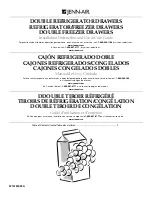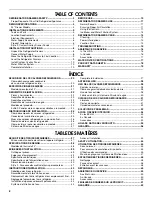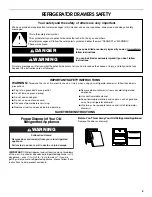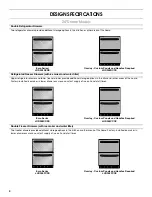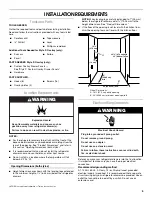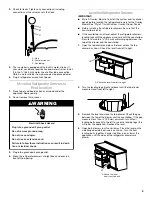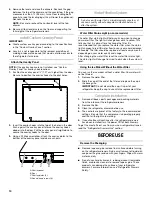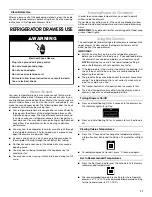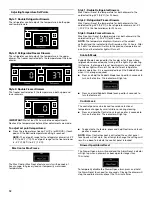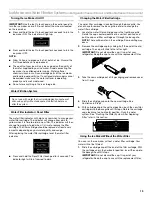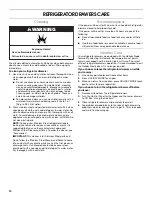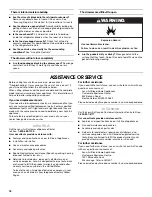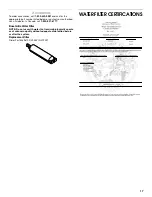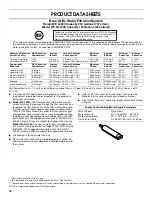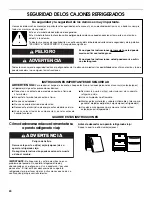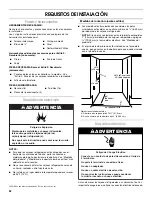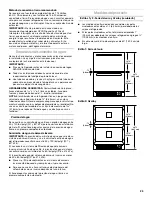
8
Top and Bottom Overlay Drawer Panel Dimensions
INSTALLATION INSTRUCTIONS
Unpack the Refrigerator Drawers
Remove the Packaging
Properly dispose of packaging. Do not use sharp instruments,
rubbing alcohol, flammable fluids, or abrasive cleaners to remove
tape or glue. These products can damage the surface of your
refrigerator drawers.
Clean Before Using
After you remove all of the package materials, clean the inside of
your refrigerator drawers before using them. See the cleaning
instructions in the Use & Care Guide.
Connect Water Supply
(on Refrigerator/Freezer Drawers and
Double Freezer Drawers only)
Connect to Water Line
1. Unplug refrigerator or disconnect power.
2. Turn OFF main water supply. Turn ON nearest faucet long
enough to clear line of water.
3. Locate a ½" to 1
¹⁄₄
" (1.25 cm to 3.18 cm) vertical cold water
pipe near the refrigerator.
IMPORTANT:
■
Make sure it is a cold water pipe.
■
Horizontal pipe will work, but drill on the top side of the
pipe, not the bottom. This will help keep water away from
the drill and normal sediment from collecting in the valve.
4. Determine the length of copper tubing you need. Measure
from the connection on the lower left rear of refrigerator to the
water pipe. Add 7 ft (2.1 m) to allow for cleaning. Use
¹⁄₄
"
(6.35 mm) O.D. (outside diameter) copper tubing. Be sure
both ends of copper tubing are cut square.
5. Using a grounded drill, drill a
¹⁄₄
" hole in the cold water pipe
you have selected.
6. Fasten the shutoff valve to the cold water pipe with the pipe
clamp. Be sure the outlet end is solidly in the
¹⁄₄
" drilled hole
in the water pipe and that the washer is under the pipe clamp.
Tighten the packing nut. Tighten the pipe clamp screws
slowly and evenly so washer makes a watertight seal. Do not
overtighten or you may crush the copper tubing.
7. Slip the compression sleeve and compression nut on the
copper tubing as shown. Insert the end of the tubing into the
outlet end squarely as far as it will go. Screw compression nut
onto outlet end with adjustable wrench. Do not overtighten.
8. Place the free end of the tubing in a container or sink, and
turn ON the main water supply. Flush the tubing until water is
clear. Turn OFF the shutoff valve on the water pipe. Coil the
copper tubing.
Connect to Refrigerator
1. Attach the copper tube to the valve inlet using a compression
nut and sleeve as shown. Tighten the compression nut. Do
not overtighten. Use the tube clamp on the back of the
refrigerator to secure the tubing to the refrigerator as shown.
This will help avoid damage to the tubing when the
refrigerator is pushed back against the wall.
2. Turn shutoff valve ON.
A. Overlay hook locations
B. Route
¹⁄₈
" deep
Reverse Side
23
⁵⁄₈
"
(60.0 cm)
14
⁷⁄₈
"
(37.8 cm)
¹⁵⁄₁₆
" (2.4 cm)
4
¹⁄₈
"
(10.5 cm)
¹³⁄₁₆
"
(2.1 cm)
2
³⁄₁₆
"
(5.6 cm)
¹³⁄₁₆
"
(2.1 cm)
A
¹⁵⁄₁₆
"
(2.4 cm)
1
³⁄₄
"
(4.4 cm)
R
¹⁄₁₆
"
(1.6 mm)
min.
B
Pilot Holes
¹⁄₁₆
" (1.6 mm) diameter x
³⁄₈
" (9.5 mm) deep
8 places
WARNING
Excessive Weight Hazard
Use two or more people to move and install
refrigerator drawer(s).
Failure to do so can result in back or other injury.
When Moving Your Refrigerator Drawers:
Your refrigerator drawers are heavy. When moving the
appliance for service, be sure to cover the floor with
cardboard or hardboard to avoid floor damage. Always pull
the appliance straight out when moving it. Do not wiggle or
“walk” the appliance when trying to move it, as floor
damage could occur.
A. Cold water pipe
B. Pipe clamp
C. Copper tubing
D. Compression nut
E. Compression sleeve
F. Shutoff valve
G. Packing nut
A
B
C
D
E
F
G

